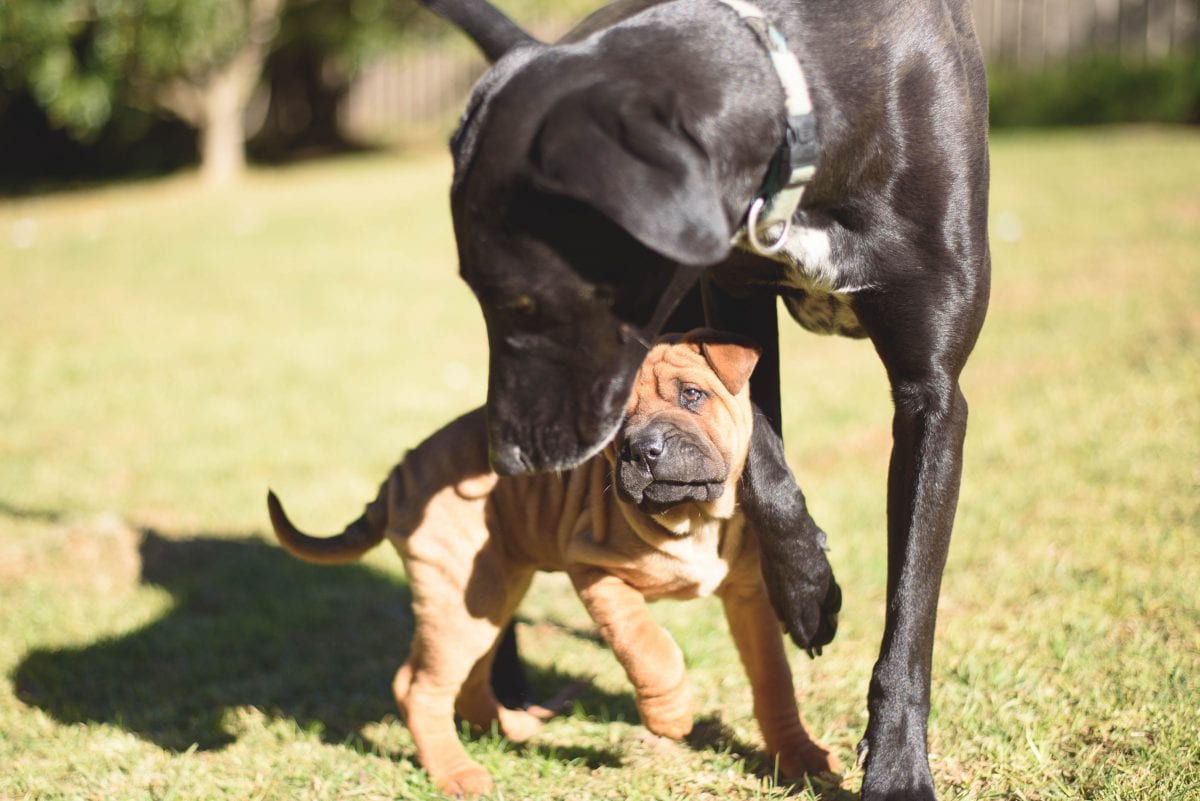Puppies are full of fun and playfulness, so it can be a real joy to watch them frolicking with their fur-pals! Some doggos may take a while to warm up to your fluffy friend, so here are some puppy training tips to make sure his manners are on point when making new friends.
A new puppy is an exciting addition to your family – congratulations! They learn quickly, so it’s never too soon to start teaching them good manners. You’re sure to have plenty of visitors popping in to meet your new arrival, so it’s a great time to practice those doggy greetings so he can make lots of canine buddies.
How to train a puppy to greet dogs nicely
Puppies are full of enthusiasm for just about everything. While it’s adorable to watch, it can be a bit overwhelming for older doggos when they first meet each other, so getting your puppy to focus on you and calm things down is super important. Whether you go for clicker training or just use a phrase to indicate that ‘girl done good’ and she’s going to get a treat, starting out with this simple tool is a great way to ensure they keep their eyes on the prize, instead of getting into mischief. Here are our favourite techniques for introducing your puppy to other dogs (or exciting animals) in the home and out on walkies.
Start with clicker training for dogs
This is the easiest puppy training you’ll ever do! All you need to do is get your dog to associate the click sound or a praise word with getting a treat. So it’s simple – click and treat! Praise and treat! It’s best to do this when they are focused on you; you can try it with their name, like so:
You: “Fido”
Fido looks up at you.
You: Mark the good behaviour with a “Yes!” or ‘click’, and deliver the treato.
If Fido doesn’t look at you, don’t mark it or give the snack, and don’t repeat the command immediately! Little puppies need to learn that you don’t repeat yourself – they don’t get to choose when (or if) they respond. And always use the same praise word and tone-of-voice if you choose not to rely on a clicker. ‘Yes!’ works really well.
? Good Boy Top Tip: try to avoid using your pupper’s name negatively. It’s best to give them a command instead, like “get down” or “leave it”, so they know what you want them to do. Keep their name for getting their attention without any negative feelings attached.
Why do you need to use a clicker or praise word? Well it’s simple – it allows you to reinforce a behaviour (let the doggo know it’s a good one that gets them food) even if you’re not right next to them with a treat in your hand. As long as they can hear you and they know the treat will follow, the click or praise becomes as much a part of the reward as the snack does. It’s a great tool for all kinds of puppy training. Just remember – never click or use the magic word without delivering the reward!
Now you know the basics of rewarding behaviour to make it happen again, we can get started with the introductions! Cute doggies can attract a lot of attention when they’re out and about, so it might be best to start with the ‘at home’ method first.
Introducing dogs at home
Introducing your excitable puppy to a new friend doesn’t have to be too complicated. All you need is some treats, a stairgate or barrier they can see through, and plenty of healthy dog treats. And, of course, a willing (and preferably chilled out) canine assistant and owner.
Set up the stairgate with you and your bundle of fluff on one side, and the assisting doggo and owner on the other. Get the mature doggo to lay down within sight of the puppy. The little pupper will probably do something totally adorable, like trying to get to the dog and making cute noises. Ignore that (we know, it’s hard) and call your puppy over to you, or give the command to look at you. If you can get her to come to you that’s great, but it’s pretty unlikely at this stage, so just settle for eye contact. Every time the puppy looks at you instead of pawing at the gate, click/praise (‘mark’) and reward. Eventually, you will get to the point where the little one will obey simple commands that they already know (sit, lay down).
That means you can bring the older dog a little closer and start to build up your puppy’s focus on you again. Keep doing this until the dogs are next to each other on either side of the gate and not displaying any signs of over-excitement. Then, you can introduce them by opening the gate. Hopefully, they will sniff each other and begin to interact in a respectful way. Remember, it’s okay for them to be excited – doggos often love puppies as much as we do – but the trick is to maintain control at all times. Keep practising getting your puppies attention in between playing so you can make sure he’s not getting too carried away (and call him off if he does)!
Introducing dogs on a walk
If you want to introduce your puppy to other dogs out and about, there are a few little tricks to ensure it goes smoothly. This is particularly useful for slightly bigger puppies, as it keeps them moving and lets them have some real rough and tumble when both doggies are ready!
Start off with both dogs on the lead at a distance apart that allows you to keep your puppy’s attention. You can begin by walking around each other in big circles, so you stay the same distance away and keep your pupper’s focus squarely on you. Use the clicker method mentioned in the ‘at home’ technique above to draw their focus onto you if they are too interested in their new friend. Lots of dog treats and reinforcement for focus and good behaviour will tell your little ball of fluff that it’s not playtime – yet!
If you’re around dogs you don’t know you can practice this by getting your doggo’s attention even when he wants to go and make friends. The more you can handle this type of excitement together, the easier it will be when other pooches come to introduce themselves, as your fur-pal will know he needs to keep calm and keep an eye on you. Make sure you check with the other owner before allowing yours to go and say hello, as some pups can be too nervous for making new doggy friends.
Once both doggies are good at this, you can start to work your way closer and closer. If either of them get over-excited and start pulling, whining or barking, just back off until they calm down and try again from that distance, moving closer more slowly this time.
Once you’re within a few metres of each other, you can start walking with the adult dog in front, and the puppy behind, close enough to sniff but not to engage in play. Swap places so both doggies get the chance to do some sniffing.
Follow this by standing next to the other owner and getting the doggos to do some ‘sits’ and ‘downs’. If they are nice and calm, it’s time to allow the dogs to greet each other! Aim to keep their focus, so you can give simple commands and get a good response. Then, allow them a little more freedom – perhaps some playtime with the leads on. Call your puppy back regularly so they know they have to focus on you. Let your pupper to know that over-excitement gets him moved further away from the doggo, and calmness allows him closer. He’ll pick it up in no time!
It may take many tries to get to this point, which is where off-lead play can be introduced, so break it down into stages and try it over a few days. This is great dog training for older fur-pals, too – they’re never too old to learn more manners!
? Good Boy Top Tip: Make sure your pup’s recall is excellent before allowing off-lead playtime outside of your garden, as even the most obedient doggos can get carried away and run off in hot pursuit of their new friend!
Other puppy training tips
Some puppies love toys more than treats, while others live for a pat on the head. We know that super smelly treats are great for training, too! Find a reward that works well for your faithful friend, even if everyone else seems to be using cheese!
There are lots of other ways to practice introducing puppers and doggos, so keep reading around the topic and trying new things. Different tricks work for different dogs! Some may love playing tug with their new friends, while others may ‘resource guard’ their toys.
Some dogs are naturally friendly and feisty, while others may be shy and retiring. Look out for signs of stress in both doggys, so you can initiate a little bit of chill time if you need to.
Remember, very old dogs, or those that are sick, injured or disabled, may just be unsuitable playmates for your fluffy friend, however much you want them to get on. Focus on doggos that are a good match and reward good behaviour with lots of puppy treats and praise and you’ll have a beautifully socialised pupper in no time at all.




